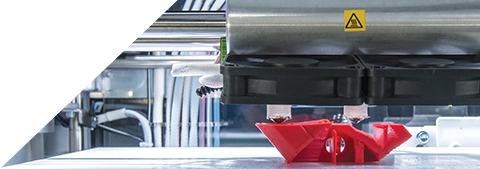Completed with thermoplastic materials, our 3D printing offers flexibility, machinability and higher-temperature resistance for engineers and professional applications.
What is 3D Printing?
3D Printing, also known as Rapid Prototyping, is the process of quickly engineering 3D prototypes, parts, or mockups of what a product will eventually look like. These prototypes are typically used to test the product’s technical feasibility or consumer interest.
There are several common terms that are frequently used when referring to this type of technology. Some of the more popular names include: Rapid prototyping (RP), 3D Printing, Fused Deposition Modeling (FDM), and Additive Manufacturing.
Benefits of 3D Printing
- Fast and effective communication of design ideas.
- Effective validations of design, fit, form, and function.
- Fewer production design flaws and better end products.
- Greater design flexibility, with the ability to run multiple design versions.
Build Dimensions & Resolutions
Our 3D printing machines have a platform which allows the production of parts with a maximum build size of 12x12x18″. Though, larger parts are not a problem! We can slice oversized parts into multiple STL files to be built separately and then assembled after completion. Layer Resolutions along the X and Y axis are either 0.004″ (0.101mm), or for times when you don’t need the nest dimension resolution, our printers let you speed up printing with a layer thickness of 0.010″ (0.254 mm) for faster 3D printing. The minimum wall thickness for a part is either 0.030″ (0.76mm) for 0.004″ layer resolution parts, or 0.050″ (1.27mm) for 0.010″ layer resolution parts.
3D Material Options
The process of 3D printing is done with durable thermoplastic materials that become soft and moldable when heated, and return to a solid when cooled. Specifically, Manufacturing Methods prints with ABS and PLA, which are strong plastics with mild flexibility that can take many forms.
Inside the 3D printer, the ABS plastic travels through a tube to the print head, where it’s heated to a semi-liquid state and extruded in thin, accurate layers. Their strength, flexibility, machinability, and higher-temperature resistance make it a preferred plastic for engineers and professional applications. Dimensional parts built in ABS and PLA plastic have been used for both functional and field tests—from wind tunnel testing, to camera mounts on a M1A Bradley tank, to a spray gun running at 60 psi.
How does rapid prototyping work?
Rapid Prototyping (RP) is an additive manufacturing technology used to build a physical, three-dimensional part by gradually applying layer upon layer of material. The process begins with taking a virtual design from Computer Aided Design (CAD) software. The 3D printing machine reads the data from the CAD drawing and lays down successive layers of liquid, powder, or sheet material—building up the physical model from a series of cross sections. These layers are automatically joined together to create the final shape. Rapid Prototyping uses a standard data interface, known as the STL file format, to translate from the CAD software to the 3D prototyping machine. The STL (Standard Tessellation Language) file approximates the shape of a part or assembly using triangular facets.
What is Fused Deposition Modeling?
Fused Deposition Modeling (FDM) is a solid-based Rapid Prototyping process that extrudes production-type materials, layer by layer, to build a 3D model. The build material is added to the FDM machine in a filament form contained in a cartridge. The FDM machine feeds the material from the cartridge up to a head that heats and melts the material. The head traverses in an X and Y direction, and extrudes material onto a platform to create a two-dimensional cross section of the model. The material quickly solidifies, and the build platform drops where the next layer is extruded upon the first. This process continues until the 3D model is complete. FDM prototypes are high strength, functional, and hands-on prototypes.
How long Does 3D Printing Take?
Typically, Rapid Prototyping systems can produce 3D models within a few hours. Yet, this can vary widely, depending on the type of machine being used and the size and number of models being produced. Your order can usually be printed and shipped to you within just a few days.
Contact Manufacturing Methods now and let us show you how we can build your next product using our exciting new 3D printing process!

